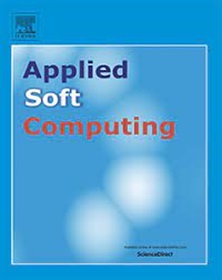Adaptive fuzzy entropy optimization with opposition-based archimedes search for robust multilevel image segmentation
IF 6.6
1区 计算机科学
Q1 COMPUTER SCIENCE, ARTIFICIAL INTELLIGENCE
引用次数: 0
Abstract
Image segmentation plays a critical role in diverse computer vision applications. Multilevel thresholding (MLT) remains one of its most widely used unsupervised techniques due to its simplicity and interpretability. However, existing MLT methods often suffer from two major limitations: (1) the inability to adapt to local intensity variations and (2) the computational burden associated with high-dimensional threshold search. To address these challenges, this study proposes a novel segmentation framework that integrates a Proximity-Adaptive Fuzzy Entropy (PAFE) model with an Opposition-Based Learning-enhanced Archimedes Optimization Algorithm (OBL-EAOA). The PAFE model utilizes dynamically adjusted trapezoidal membership functions based on intensity proximity to candidate thresholds, allowing for a more adaptive and smooth entropy surface. Meanwhile, the OBL-EAOA enhances optimization performance through opposition-based learning and adaptive parameter control, improving exploration diversity and convergence speed. The proposed PAFE-EAOA framework is validated on two benchmark datasets, BSD500 and PASCAL VOC 2012, using five standard metrics: PSNR, SSIM, FSIM, SNR, and computation time. Compared with several state-of-the-art methods including Kapur Entropy (KE)-EAOA, Fuzzy Entropy (FE)-EAOA, Patch-Levy-Based Bees Algorithm (PLBA), Marine Predators Algorithm (MPA), Improved Grey Wolf Optimizer (IGWO), and standard Archimedes Optimization Algorithm (AOA), the proposed approach consistently achieves superior segmentation quality. Notably, it reduces computation time by up to 60 % and achieves statistically significant improvements, as confirmed by the Wilcoxon signed-rank test. These results demonstrate the framework’s robustness, scalability, and effectiveness for real-world MLT-based image segmentation.
基于阿基米德搜索的自适应模糊熵优化鲁棒多级图像分割
图像分割在各种计算机视觉应用中起着至关重要的作用。多层阈值(MLT)由于其简单性和可解释性,仍然是应用最广泛的无监督技术之一。然而,现有的MLT方法通常存在两个主要局限性:(1)无法适应局部强度变化;(2)与高维阈值搜索相关的计算负担。为了解决这些挑战,本研究提出了一种新的分割框架,该框架将近似自适应模糊熵(PAFE)模型与基于对立的学习增强阿基米德优化算法(OBL-EAOA)相结合。PAFE模型利用基于强度接近候选阈值的动态调整梯形隶属函数,允许更自适应和平滑的熵面。同时,OBL-EAOA通过基于对立的学习和自适应参数控制增强了优化性能,提高了勘探多样性和收敛速度。在BSD500和PASCAL VOC 2012两个基准数据集上,使用5个标准指标:PSNR、SSIM、FSIM、SNR和计算时间,对所提出的PAFE-EAOA框架进行了验证。与Kapur Entropy (KE)-EAOA、Fuzzy Entropy (FE)-EAOA、Patch-Levy-Based Bees Algorithm (PLBA)、Marine predator Algorithm (MPA)、Improved Grey Wolf Optimizer (IGWO)和标准Archimedes Optimization Algorithm (AOA)等几种最先进的分割方法相比,该方法均能获得较好的分割质量。值得注意的是,它减少了高达60%的计算时间,并实现了统计上显著的改进,正如Wilcoxon符号秩检验所证实的那样。这些结果证明了该框架在现实世界中基于mlt的图像分割方面的鲁棒性、可扩展性和有效性。
本文章由计算机程序翻译,如有差异,请以英文原文为准。
求助全文
约1分钟内获得全文
求助全文
来源期刊

Applied Soft Computing
工程技术-计算机:跨学科应用
CiteScore
15.80
自引率
6.90%
发文量
874
审稿时长
10.9 months
期刊介绍:
Applied Soft Computing is an international journal promoting an integrated view of soft computing to solve real life problems.The focus is to publish the highest quality research in application and convergence of the areas of Fuzzy Logic, Neural Networks, Evolutionary Computing, Rough Sets and other similar techniques to address real world complexities.
Applied Soft Computing is a rolling publication: articles are published as soon as the editor-in-chief has accepted them. Therefore, the web site will continuously be updated with new articles and the publication time will be short.
 求助内容:
求助内容: 应助结果提醒方式:
应助结果提醒方式:


